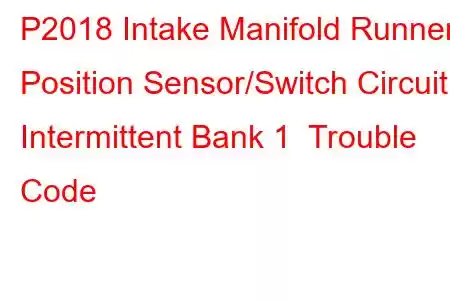P2018 Intake Manifold Runner Position Sensor / Switch Circuit Intermittent Bank 1
OBD-II Trouble Code Technical Description
Intake Manifold Runner Position Sensor / Switch Circuit Intermittent Bank 1
What does that mean?
This generic powertrain/engine diagnostic trouble code typically applies to fuel injected engines from most manufacturers since 2003.
Those manufacturers include but are not limited to Ford, Dodge, Toyota, Mercedes, Volkswagen, Nissan and Infiniti.
This code is mostly concerned about the value provided by the intake manifold flow control valve/position sensor, also called known as a IMRC valve/sensor (typically located at one end of the intake manifold) which helps the vehicle’s PCM control the amount of air being allowed into the engine at various RPMs. This code is set for Bank 1, which is the bank of cylinders that includes cylinder number 1. This can be a mechanical or an electrical circuit fault, depending upon vehicle manufacturer and fuel system.
Troubleshooting steps may vary depending upon manufacturer, type of fuel system and the type of intake manifold runner control valve/position (IMRC) sensor and wire colors.
Symptoms
Symptoms of a P2018 engine code may include:
Malfunction Indicator Lamp (MIL) illuminated Lack of power Occasional misfire Poor fuel economyCauses
Typically, the causes for this code to set are:
Sticking/faulty throttle plates/body Sticking/faulty IMRC valve Faulty IMRC actuator/sensor Rarely - faulty Powertrain Control Module (PCM)(programming required after replacement)
Diagnostic Steps and Repair Information
A good starting point is always to check for technical service bulletins (TSB) for your particular vehicle. Your issue may be a known issue with a known fix put out by the manufacturer and can save you time and money during diagnosis.
The more common failure items (and most commonly misdiagnosed items) on these systems are: the IMRC vacuum solenoids, as carbon builds up inside the vent portion and does not allow them to vent properly if at all and the second is the IMRC plates sticking/binding due to carbon deposits around them.
First, note if there are any other diagnostic fault codes. If any of them are intake/engine performance system related, diagnose them first. Misdiagnosis has been known to occur if a technician diagnoses this code before any intake/engine performance related system codes have been thoroughly diagnosed and dismissed. Insure there are no intake or exhaust leaks. An intake leak, or vacuum leak, makes the engine run lean. An exhaust leak gives the impression of a lean running engine by the air fuel ratio/oxygen (AFR/O2) sensor.
The next step in this process is to locate the IMRC valve/sensor on your particular vehicle. Once located, visually inspect the connectors and wiring. Look for rubbing, scraping, bare wires, worn spots or melted plastic connectors. Pull the connectors apart and carefully look at the terminals (the metal parts) inside the connectors. Check to make sure they are not burnt or corroded. If in doubt, get some Electrical Contact cleaner at any parts store if cleaning of the terminals is needed. If not possible, get some rubbing alcohol and a small plastic bristle brush (worn out tooth brush) to clean them. Once cleaned, let them air dry. Pack the connector cavity with dielectric silicone compound (same stuff they use for light bulb sockets and spark plug wires) and reassemble
If you have a scan tool, clear the diagnostic trouble codes from memory, and see if this code returns. If it does not, then the connections were most likely your problem.
If the code does return, we will need to test the IMRC valve/sensor voltage signals to and from the PCM. Monitor IMRC sensor voltage on your scan tool. If a scan tool is not available, then test the signal coming from the IM
Read: 22


